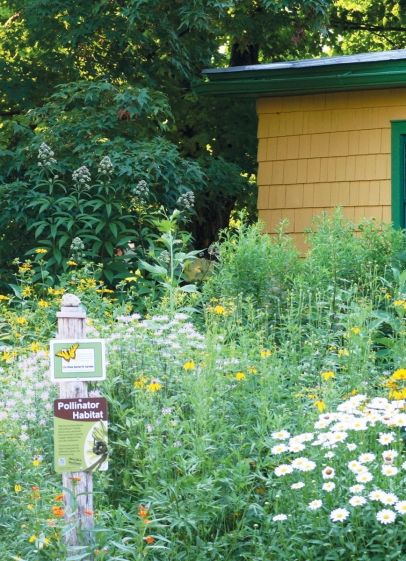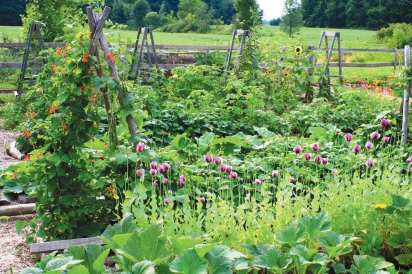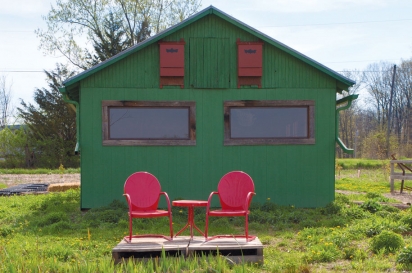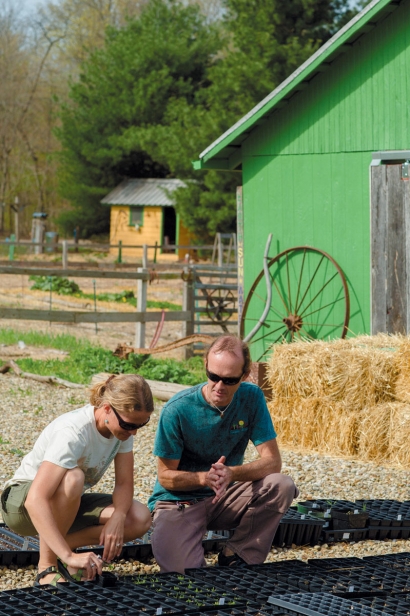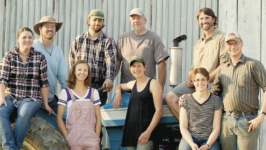The Common Milkweed
Ohio homesteaders growing milkweed for the monarchs
The common milkweed, perceived by many as an invasive vine, is easily forgotten. Yet to North America’s most iconic butterfly, the monarch, the flowering plant is both a rich, scented herb and a critical factor in its survival. For this reason, the milkweed and other species of oft-neglected native plants are valuable partners of homesteading entrepreneurs Jennifer Kleinrichert and Stephen Ross.
Jennifer and Steve chose the common milkweed as their inspiration because it represents the “imperceptible interface” between growing food and creating native wildlife habitats to which they have committed both their personal and professional lives. In 2010, they left their naturalist jobs in New Mexico and bought a three-and-a-half-acre property in Cardington, Ohio, about 40 minutes north of downtown Columbus. By the time you turn off the county road and pull into their driveway, the surroundings are so lush and rural that downtown Columbus feels hours away.
A year after acquiring the property, which they describe as being nothing but “grass and trash piles” at the beginning, Jennifer and Steve were living their dream of a thriving homestead where they could both grow their own food as well as create a mini-ecosystem of the native plants that attract pollinators necessary for agriculture. They both initially “worked out” for local nature organizations and managed their land around that work, but a few months ago Jennifer left her day job and made the leap into full-time growing, with the ultimate goal of running a native plant nursery as well as using the resources on their land to produce and sell homemade soaps and wood products.
They now cultivate all of their own vegetables, dried beans, and most of their fruit, and their three chickens, who live in a cozy yellow coop that matches the couple’s house, lay all the eggs they need. They transformed the property almost singlehandedly, salvaging wood for the fence and gates from local refuse. Around the tidy, well-organized edible beds grow dozens of different species of native plants carefully selected to attract native pollinators, including both honey and native bees. The plants also invite the native predatory insects that feed on plant-destroying bugs and help ensure the viability of Jennifer and Steve’s food. Strolling around the property, they casually identify each species and occasionally stoop down to protectively stroke a leaf, reminiscing about where they first encountered it and explaining its benefits. They have a variety of sun, shade, and woodland flora, plants that might flourish in different home garden settings.
The varieties are not only grown to support the couple’s diets; many of these plants also provide a valuable home for the birds, butterflies, and caterpillars that need native plant species for both homes and food, and the common milkweed is an example. Historically treated as an invasive species, milkweed has become less available as a result of deforestation and urban development.
This has led to a decline in the North American monarch population, which relies on the milkweed as a primary food source. According to The Ohio State University’s Chadwick Arboretum, common milkweed and other nectar sources for monarchs have declined as genetic crop modification and roadside management practices increase. The Arboretum also states that 90% of milkweed butterfly habitats appear within agricultural landscapes, thus creating a call to both professional planters and home gardeners to help continue to propagate these species. Jennifer’s and Steve’s homestead is a certified Monarch Waystation, designating the area as having sufficient milkweed resources to support sustainable monarch generations.
Using the common milkweed as their inspiration, Jennifer and Steve intend to build awareness and demand for it and other native plants that foster this and similar natural relationships. Their vision to accomplish this is a native plant nursery business. As Steve says, they intend to “add more people to the choir,” building consciousness of native plants and repopulating Ohio’s home gardens and farms. Launching the nursery is no small task. Beginning with seeds planted in tiny pots, they now have beds of thousands of tiny, delicate seedlings, which must be individually separated and reseeded into larger pots in order to germinate.
As the full-time member of the team, Jennifer starts her day with piles of paperwork—filing insurance and license applications and researching retail opportunities to sell their products. She also writes and updates their blog, and is always searching for assistance from conservancy organizations. They hope to be approved for a grant to build a high tunnel and to qualify for a program that helps agricultural organizations with property and structural planning. They also want to educate home gardeners about the importance of considering native plants from an agricultural perspective, in response to the reduction in pollinator plants and honeybee populations nationwide. Jennifer and Steve see themselves as critical advocates for these vital natural resources, thereby supporting both local farmers and the state’s agricultural heritage.
Asked how they succeed as both entrepreneurial partners and spouses, they simply respond that a shared passion for “growing things to eat and things to support eating” means they spend their time together doing what they love—and that never feels like a burden. They share equally the pride and love for their home with a sense of responsibility for every species on their land, and they consider the impact on each animal, bird, plant, and vegetable before bringing something new into the mix, always striving for harmony.
Their most recent addition to the land is a small wetland behind the house that immediately became home to a population of frogs and toads who happily ate the flies and slugs. Mosquitos attracted by the water also serve as food for the amphibians, as well as the bats in the barn. The water also attracts tree swallows, which Jennifer and Steve listen for eagerly every year. When the swallows begin to trill, they know that spring has arrived.
Five Native Wildflowers to Know & Grow
Courtesy of Jennifer Kleinrichert and Stephen Ross
For more ideas visit their blog, thecommonmilkweed.blogspot.com
Wild Geranium (Geranium maculatum): Shade to part-shade, 1–2 feet, purple flower, spring. Important early-season bloomer that is visited by many bee species and other beneficial insects.
Riddell’s Goldenrod (Solidago riddellii): Sun to part-shade, 2–3 feet, yellow flower, autumn. Goldenrods and asters are crucial late-season pollinator plants and no garden should be without them. Many bees gather nectar and pollen for the winter from these plants.
Wild Bergamot (Monarda fistulosa): Sun to part-shade, 2–4 feet, purple flower, summer. Very attractive to many pollinators including bumble bees, butterflies, and clearwing moths.
Butterfly Milkweed (Asclepias tuberosa): Sun, 1–2½ feet, orange flower, summer. Milkweeds are visited by myriad bees, butterflies, wasps, flies, butterflies, and even hummingbirds. They are also the host plant for the monarch butterfly.
Purple Coneflower (Echinacea purpurea): Sun, 2–5 feet, pink flower, summer. Excellent bee, butterfly, and other beneficial insect plant.


